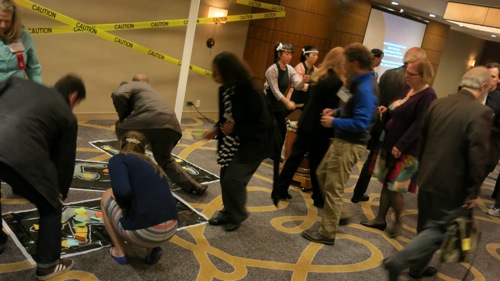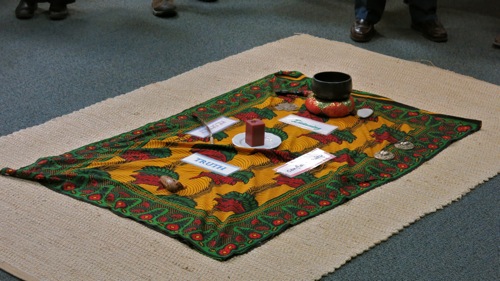On Friday afternoon at the Religious Education Association 2014 conference, I attended a colloquium with two presenters: Courtney Goto ofBoston University presented “Troubling Cross-Cultural Analysis in Healing the Effects of Racism,” and Jonathan LeMaster-Smith, doctoral student at Garrett-Evangelical Theological Seminary, presented on “Sabbath as Post-Christian Education: The (De)valuing of Rural Working-Class Persons as Liberation from Socio-Economic Disposability.”
Goto told us that she was presenting work in progress, and what she was going to present differed from the outline on the conference meeting Web site. She is working on two case studies, comparing the way two different cultural communities use aesthetic practices to form people theologically, aesthetically, and culturally.
Her first case study is of Lithuanian rituals on All Saints Day, during which families place candles and decorations at the grave sites of deceased family members. Her second case study is of an All Saints Day ritual at the Sacramento Japanese United Methodist Church.
Since Lithuanians and Japanese Americans are people on the margins, Goto’s research will use the concept of “social death” to explore these two case studies. Social death happens when a group of people is treated as nonpersons by the dominant culture. Examples of victims of social death include Jews during the Holocaust, native Americans in the U.S., etc. Both Japanese Americans and Lithuanians were victims of social death before and during the Second World War. Both communities use All Saints Day to hold rituals which serve as a response to trauma.
Of particular interest to me were the slides that Goto showed of an All Saints Day art installation in the Sacramento Japanese United Methodist Church. 26 yukata (a type of traditional Japanese clothing) were hung from from the ceiling of the sanctuary; another yukata clothed the usually plaint cross at the front of the church. The symbolism — how this art installation represents the way Japanese Americans were treated during the years of internment — was explained during services, in orders of services, etc. I felt this was a powerful example of all-ages religious education in a congregation.
Jonathan LeMaster-Smith spoke about another marginalized group, rural white working class persons. He is in the process of investigating ways to do religious education around the Sabbath in a post-Christian rural working class context. “One possible pedagogical practice is the observance of Sabbath,” LeMaster-Smith said — but not Sabbath in the traditional sense of a day of rest on Sunday (or Saturday).
Rather, LeMaster-Smith wants to ways the concept of Sabbath could be incorporated into popular culture rituals such as, for example, a Hallowe’en bonfire. (One of the participants later pointed out the obvious parallels between the Lithuanian popular culture ritual on All Saints Day described by Goto.) LeMaster-Smith said he saw potential in finding Sabbath-type observances in existing holiday celebrations.
A draft of Lemaster-Smith’s paper is online here. I saw a great deal of potential in this idea of translating the old observance of Sabbath into current post-Christian celebrations. Indeed, I believe some churches and faith communities are already on this path, e.g., many non-Hispanic congregations are incorporating Dias de los Muertos into Sunday services. LeMaster-Smith is simply asking faith communities to take this kind of thing outside the walls of the church building, out into the community. It seems to me that powerful things could happen at the intersection of pop culture and post-Christian religion.




